Congratulations to John Burrell for setting a new WUCA record for 100 Km Outdoor Velodrome in the Male, 75-79 age group on a recumbent bike.
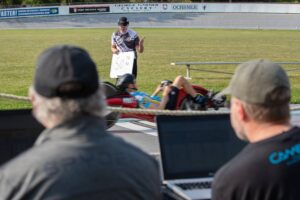
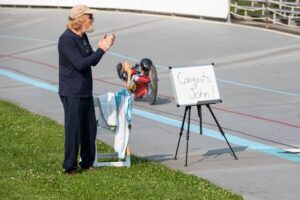
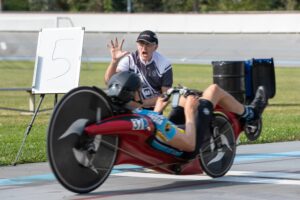
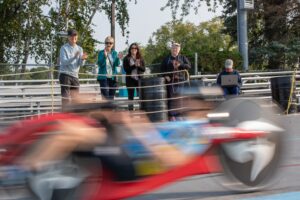
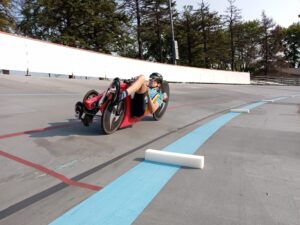
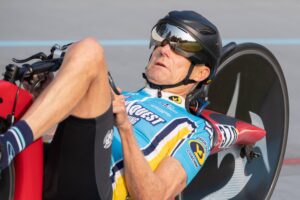
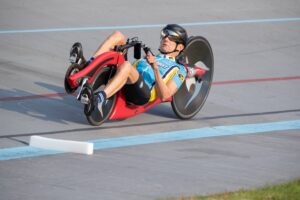
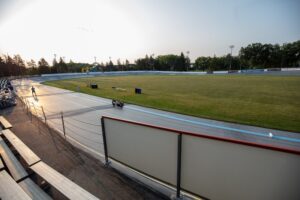
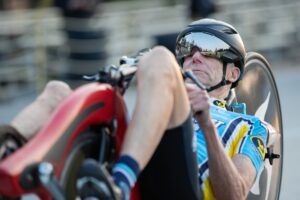
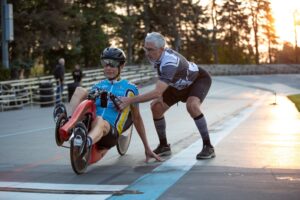
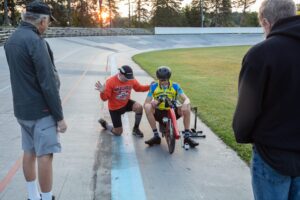
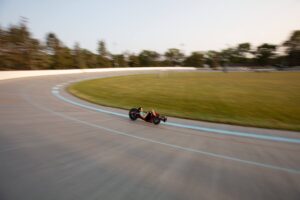
John Burrell’s September 14th, 2022 100KM Record Ride Report
I set these Goals Set July 25, 2022
Break the WUCA 75-79 age group world record for 100KM in an outdoor velodrome on September 14, 2022
- Base goal: beat the current record of 03:46:57 (16.43 mph average)
- Stretch Goal 1: 3h5m (average > 20 mph)
- Stretch Goal 2: 2h50 (average> 22 mph)
Training Base as of August 6th when I started 100KM specific training
- 3522 miles ridden YTD including 20 virtual live intensity sessions in Jan. Feb and March
- I completed 6 races this year
- Mostly 20K and 40K TTs
- I did intensity intervals 2X weekly at the velodrome for since May 12
- My longest training ride at the velodrome was 27 miles
- I rode several longer Sunday rides (60-70 miles my VTX Trike)
Race Specific Training
- 10 interval sessions Tuesdays and Thursdays at the velodrome
- Start with shorter intervals and work up to 2 X 25 miles at race pace
- 4 other days of the week do easy 10-40 miles rides.
- Focus on injury avoidance and rest
The evening before race day two officials and I went to the Ed Rudolph velodrome in Northbrook, IL and set up the timing tape, the table, the chairs, the Whiteboard the foam blocks on the turns. Race day I got up at 4:30 AM (as I had done for previous training sessions), and ate a large bowl of steel-cut oatmeal with bananas and a cup of coffee.I filled the bladder I keep behind the seat on the M1 with Skraitch hydration fluid. I also tucked an opened Clif Bar into the front of my jersey. The three officials rendezvoused at my house and we drove to the Ed Rudolph velodrome 8 miles away arriving at 6:10 a.m. It was chilly and dark with a temperature of 51 degrees but no wind. I rode a 3.7 mile warm up with 2 hard laps at over 25 miles an hour. That gave us a chance to test the electronic timer. Since it was still chilly we decided to wait to start the race until after the sun came up and warmed the air a little. The race is a 262 laps time trial and is very difficult mentally as well as physically. Larry Osland suggested I break the race down into 10K intervals so we reset my Garmin to automatically restart every 10 km. This was a good strategy because all I had to focus on was my speed, cadence and power for 10 km. It also helped me know more quickly if my speed and power was dropping. After about 30 km I knew there was a calibration problem. Garmin showed 30k completed at 23.6 miles per hour but the electronic timing system showed less distance at a speed of 22.35 miles per hour. Also my power dropped steadily over the course of the race. In my first 10K the normalized power was 165 watts and in the final 10K my normalized power was 144 watts. I was able to stay focused and planned to push after 80 km but when I tried to put out more power cramps hit me. So I had to spin and soft pedal. Meantime when my Garmin said I finished 90k the electronic system said I only completed about 84k. I ignored this and kept pushing as hard as I could. When Garmin told me I completed the 100K the electronic timer said I had 15 long laps to go. Thank goodness the lap board countdown motivated me to push all the way to the finish. When I finished I could not stand and had to be helped up. When I finally stood I almost blacked out. Fortunately my wife put a bottle with Skraitch recovery in my mouth. Scratch recovery stopped me from feeling sick. A few minutes later I ate the untouched Clifbar tucked in my jersey front.
Epilogue: Larry Oslund as head official was as perplexed as I was that my Garmin Edge 1030 showed I rode over 66 miles at a 23.3 mph average vs. the electronic timer stats of 62.14 miles (100km) at a speed of 22.13 mph. This is a 5% difference. After some research we changed my Garmin GPS default setting to 1 sec. Next day Larry went to the Velodrome (I stayed home since I felt a bit sick) and rode with his Garmin Edge 1000 and my Garmin and Strava activated on his phone all at the same time. After ascertaining the Velodrome is exactly 381.8 meters per lap Larry was able to confirm that the changed GPS setting on my Garmin Edge 1030 made it the most accurate of the 3 devices. With the new GPS setting of 1 sec. my Garmin Edge 1030 GPS was >99% accurate. My Garmin Edge 1030 has always been accurate on the road, Apparently Velodrome laps confused it. So the key is to use the 1s GPS setting for maximum accuracy.
